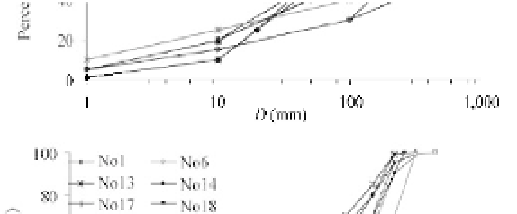Environmental Engineering Reference
In-Depth Information
flows occurred along the Mianyuan River between Heidongyan and Hanwang. The distance between twoslope debris
flows was only several tens of meters. The slope debris flows moved slowly and traveled for a distance of only several
tens of meters. Thus, slope debris flows caused no casualties but caused great damage to highways and rivers.
4.3.4.3
Slope Debris Flows Are Two-phase Debris Flow
Slope debris flows are generally two-phase debris flows because there included very little of clay and silt.
Figure 4.62 shows that size distribution of some of the 19 slope debris flows in the Wenchuan Earthquake
area. The particles finer than 1mm were less than or much less than 10% of the total solid materials. The
median diameter was between 20-200 mm for the debris flow deposits. There was only 1-2% of clay
and silt in the solid materials. Collisions between solid particles consume a lot of energy and, therefore,
the velocity of slope debris flow was very low. The velocity of the slope debris flows was calculated at
only several centimeters per second with Eq. (4.7). The slope debris flows traveled for a distance of only
several tens of meters. The low velocity resulted in the short travel distance and high slope of deposit.
Fig. 4.62
Cumulative size distribution of some of the 19 slope debris flow deposits in the Wenchuan Earthquake area
4.3.4.4
Deposits of Slope Debris Flows
Most of the slope debris flows consisted of two parts: formation section and deposit. The formation
section was in fact at the deposit of an avalanche or the deposit fan of grain erosion, which had a high
slope with an average value of about 38°. The head of the deposit of a slope debris flow took the form of
a “tongue.” The volume of deposits varied and depended on the scale of the slope debris flow. The surface
slope of slope debris flow deposits ranged from 6° to 21° with an average value of about 10°. The slope
of the deposits is much higher than for normal debris flow in gullies. If a slope debris flow occurred on a
long slope, there was a flow section between the formation section and the deposit. The surface slope of
the flow section was lower than that the formation section, but higher than that of the deposit.
Figure 4.63 shows the deposit slope of debris flows as a function of drainage area for slope debris
flows in the earthquake area and normal debris flows in the Jiangjia Ravine in Yunnan (Kang, 1996). The







Search WWH ::

Custom Search